It’s the toughest defense in the country against the most productive offense in the country. A No. 1 seed against a No. 2 seed. Last season’s National Player of the Year against this season’s National Player of the Year. An undefeated squad defending its championship against a program making its deepest tournament run in decades.
In other words? When South Carolina meets Iowa in the women’s Final Four on Friday night, they’ll offer a dream clash of styles, personalities and story lines. All this is reflected in the ticket prices (high), the expected television ratings (ditto) and the palpable sense of hype (just as impressive if not harder to objectively measure). The NCAA couldn’t have asked for a more storybook matchup.
Both teams, of course, are here partially because of their balance and depth. But the twin engines of all this buildup are clear.
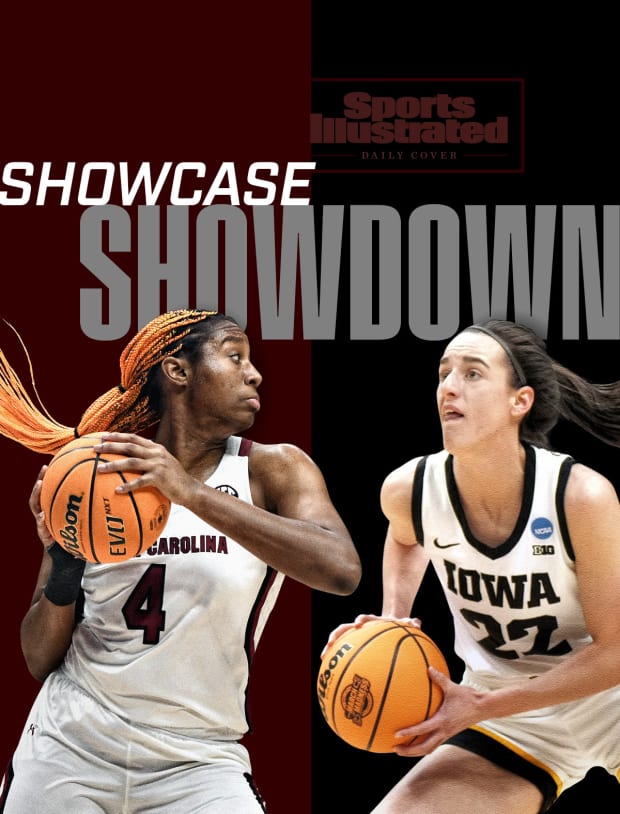
Christopher Hanewinckel/USA TODAY Sports (Boston); Kirby Lee/USA TODAY Sports (Clark)
It stems from two players: Aliyah Boston of South Carolina and Caitlin Clark of Iowa. They represent two of the most dynamic college players in recent memory. But their games are strikingly different—which is precisely the fun.
“It's almost like comparing apples to oranges,” said Iowa coach Lisa Bluder. “You really can't do that with these two players. They both bring a completely different skill set and they're both excellent at what they do.”
Boston ran the table on national awards in 2022. Averaging a double double—16.8 points and 12.5 rebounds—she made her impact on every possession feel inevitable. This year, her game has looked somewhat different: She’s been guarded more aggressively by opponents, often not just double-teamed or triple-teamed but quadruple-teamed, and she’s had to adjust her play accordingly. But make no mistake. Her numbers may have dipped—13.2 points and 9.8 rebounds—but teammates say her game has gotten better. Sure, opponents grant her vanishingly little space. Yet she always finds a way to make sure the game flows through her.
“The word that comes to mind is ‘sacrifice,’” said South Carolina coach Dawn Staley. “Aliyah Boston had staggering numbers last year. They’re less staggering this year because she really doesn’t care [about personal numbers]. She wants to win a national championship. … I do think she’s the best player in the country for what she has to endure. Through it all, she continues to make the right basketball play for our basketball team. And she sacrificed her stats for that. I think she’s well aware of what our team needs.”
To watch Boston in the paint is to get the sense that she has the ability to end each night with 35 points and 15 rebounds—if she chooses. Her efficiency and physicality are just that impressive. Instead, though, she tends to make her presence felt more subtly, taking control of the pace and facilitating the game on both ends of the floor. She takes the opposing focus on her and uses it to create space for her teammates. Staley notes that two of Boston’s fellow senior starters—Zia Cooke and Brea Beal—have enjoyed the best seasons of their careers this year. She attributes that to Boston. And players up and down the roster sing her praises as a leader.
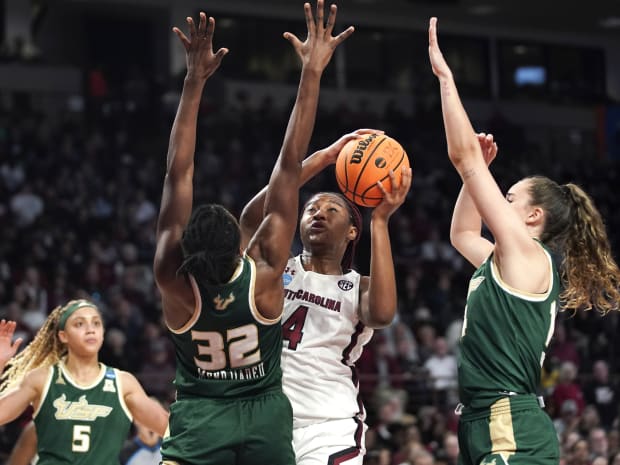
Sean Rayford/AP
“Nothing rattles her,” South Carolina guard Raven Johnson says. “They could throw a quadruple team at her or triple team at her. … She’s so poised.”
While Boston was racking up national accolades at the Final Four last year, Clark was in the audience, a runner-up for just about every award. People told her that she would have a chance to win next year. But that wasn’t her goal. At one point, she turned to Iowa associate coach Jan Jensen, who’d accompanied her on the award circuit. “I said, I just want my team to be with me next year,” Clark recalled. “Whether I won or not, it means we're at the Final Four competing.” This was the dream that drove her.
Clark got her wish. She made it back, she won the awards and this time, her whole team was with her. She both scored more (27.3 ppg) and assisted more (8.6 apg) than she did last year. And when she collected the trophy for Associated Press Women’s College Basketball Player of the Year on Thursday, her teammates squeezed into the first two rows of the press conference, sweaty from the practice they just had. Jensen ran up front to snap a few photographs before Clark was introduced: not of the star player herself (Jensen would take some of those later) but of the rest of the team grinning on plastic chairs in the media room. This kind of team presence—this kind of team success—felt like what had been missing last year.
Which hits on one of the key differences between this year’s team and last year’s. Clark may generate considerable attention for her scoring: Her range is reasonably described as “everywhere.” But her passing is just as critical. The fact that her teammates have been able to deliver on more of those passes this year is a symbol of the growth from everyone around her.
“Obviously, she’s going to attract so much from the defense,” Iowa senior McKenna Warnock says of Clark. “But she just turns so many people’s heads and somehow hits you with an amazing pass. It’s something you definitely have to learn through time in order to be ready for those passes. And I mean, she’s a risky passer.”
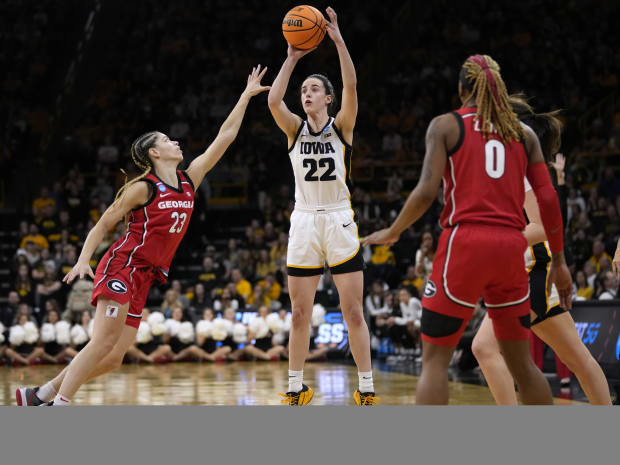
Charlie Neibergall/AP
What does it look like to learn that? Spending a few practices getting hit in the head by surprise passes?
“Yeah,” Warnock laughs. “No, seriously, getting hit in the head, getting hit in the back, the face, everything like that. But I think that’s part of why we’ve been so good this year is our ability to catch those passes at any point.”
This risk-taking is apparent everywhere in Clark’s game. (Hello, logo shots and buzzer-beating threes.) But one of the biggest changes in her play this year is how she modulates it.
“She’s definitely a very fiery person,” says Iowa center Monika Czinano. “But she’s grown so much in her ability to kind of know a time and place. … She’ll tell you herself, she’s a riskier basketball player, and her ability to kind of realize situations where she needs to tone that down, or where it’s O.K., that’s really developed.”
It’s all enough to make her look like a generational talent—just as Boston does.
There can be an impulse in women’s college basketball coverage to view everything through the lens of what it means for the sport—for its welfare, for its growth, for its future potential. The reflex is understandable. But it can feel misplaced. The focus on the game’s standing in the larger sports landscape can almost overshadow the game itself. So, yes, South Carolina vs. Iowa, Boston vs. Clark, is a sign of how the sport has grown and of the mainstream cultural interest that can develop around standout players like these. But it’s also simply phenomenal basketball—no qualifiers and no additional context needed.
“America gets to see two fabulous, spectacular basketball players in the same 40 minutes,” Bluder said. “It doesn’t get a lot better than that.”
WHAT TO WATCH FOR
Brea Beal on Caitlin Clark: Staley demurred Thursday when asked who might guard Clark. “In our locker room, yes, they’re super competitive. They all want a chance to guard her,” Staley said. “It’s going to take all of them, probably, and more to guard Caitlin. She is someone that is unpredictable. … So we got to show her different looks in order for us to hopefully keep her somewhat under control.” But even if the job switches up throughout the night? It’s hard to imagine the primary assignment will go to anyone other than Beal.
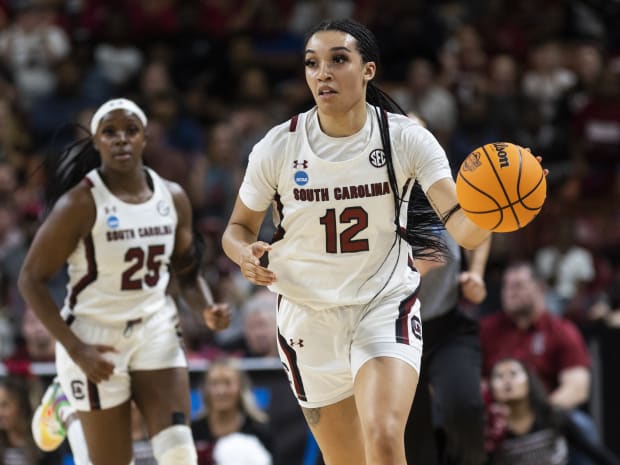
Mic Smith/AP
The Gamecocks senior has evolved into one of the best perimeter defenders in the country. She’s typically put on the opposing leading scorer, and with great speed for her size and a fantastic mind for breaking down offensive schemes, she often shuts them down. Remember last year’s national championship, when South Carolina bested UConn, in large part because star guard Paige Bueckers was held to just 14 points despite playing 39 minutes? That was Beal. Much of the attention around this Gamecocks defense is on its rebounding and shot-blocking abilities. (With good reason: South Carolina leads the nation in both.) But a huge part of their defensive power comes from Beal—locking down the perimeter and limiting opponents’ usual offensive weapons.
“Brea has been our utility player,” Staley said earlier in the tournament. “She gives us what we need at any given time. … Her confidence is at an all-time high.”
Clark hasn’t faced a defender this season quite like Beal. Then again? Beal hasn’t had an assignment quite like Clark.
Can you spot a Monika Czinano dribble? Good luck. If the Iowa center hasn’t completely extinguished dribbling from her game, she has at least made it critically endangered, something you might see in the wild just once every few weeks. Survey a few of her teammates on the last time they believe they saw her dribble: No one could remember the last time she let the ball hit the floor. (Which is apt for a player who dribbled just 18 times in the regular season last year.) But Czinano is quick to volunteer her own memory—by her count, she has dribbled this month, even if only twice. (There was once against Colorado in the Sweet 16, she says, and once against Louisville in the Elite Eight while trying to draw a foul.) It’s not that she never dribbles. It’s just that she needs a very good reason to do so. This is the game plan of Jensen, and in Czinano’s fifth year on the team, she has perfected it. “Coach J is always like, If you’re going to dribble, there’s got to be a purpose,” Czinano says. “So every once in a while, I will. But I just feel like I really don’t need to.”
To be clear: It's not that Czinano doesn’t have the ball often. (Much to the contrary.) She’s Iowa’s second-leading scorer, behind Clark, averaging 17.2 points a game. She has started every game this season. The graduate student is a model of efficiency in the paint—Czinano’s 68% field goal percentage is seventh among Division I players. But a big part of that, she says, is because of how she handles the ball. The rest of the team knows to feed her down low. She knows how to quickly convert those passes into baskets without letting the ball hit the floor. And opponents don’t know how to stop it.
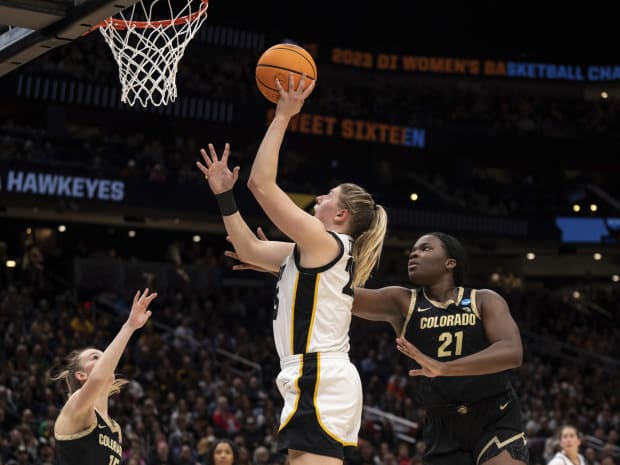
Stephen Brashear/AP
“I think being an undersized five, at my position, I kind of have to use anything I have, be quicker,” says Czinano, who is 6'3". “I think it truly allows me so much more time to kind of establish myself and make my move when I don’t have to use that dribble. It allows the defense time to collapse.”
So if you see her dribble? There’s probably a good reason. But that doesn’t mean it will look any less out-of-place.
“It’s just always bizarre, seeing her dribble,” Iowa guard Kate Martin laughs. “We’re like, Mon, no!”
It’s all but impossible to outplay the Gamecocks. Yet it’s maybe even more difficult to wear them down.







